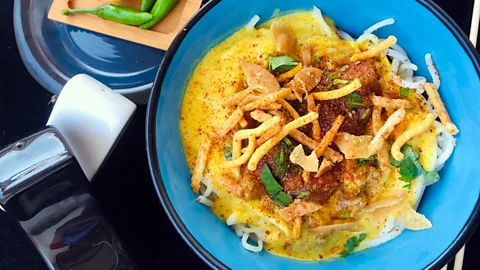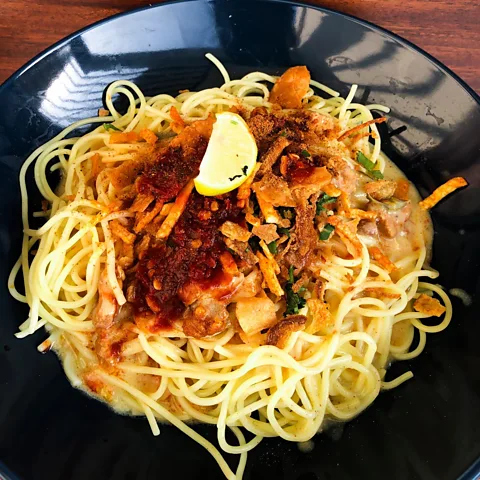By Aysha ImtiazFeatures correspondent

 Raheel Shaikh
Raheel ShaikhBrought to India and Pakistan by Burmese migrants, this soupy spaghetti curry is topped with a fiery mound of chicken or beef and showered with crunchy condiments.
Khowsey is a beloved spaghetti curry in Karachi, Pakistan, with different dialects spelling and pronouncing it as khao suey, khoi soi, khowsa, khawsa and many other ways. It is championed most fervently by the Memon community, a Muslim ethnic group known for their affinity for trade and entrepreneurial prowess in the city. However, historically, it isn't a Pakistani dish at all.
Memon businessmen and traders who had established themselves in British-occupied Burma (now Myanmar) in the 19th Century were forced to return to the subcontinent after the military junta regime in the 1960s. When they returned to Pakistan and India, they brought a version of flavourful Burmese Ohn-No Kyaukse, noodles with chicken in a coconut milk-based broth (often thickened with chickpea flour). When the Memon traders settled in Karachi, they made the dish their own by heaping on the spice and zest. They swapped out egg noodles for easily accessible spaghetti, and a served rich curry made with yoghurt and gram (chickpea) flour on the side to drown the noodles, before adding a decadent, fall-apart meat gravy on top.
More recently, fried condiments have been included to bring texture and complexity to the dish and add crackling crispiness: crunchy samosa patti (long broad strips made from wheat flour that are used to wrap samosas), papdi (deep fried flour crackers), peppery potato crisps (called Slims) colloquially dubbed "Karachi's official chips", garlic slivers, onions and even fried spaghetti. Piquant freshness is added with green chilies, coriander, lemon wedges and the occassional green onion. But the sprinkling of ubiquitous chaat masala (a spicy and sour spice mix that is often made with ground mango powder) makes the dish Pakistan's own, with many choosing to add boiled eggs as well. The end result is addictive and delicious, but the myriad ingredients and painstaking preparation result in many Pakistanis preferring to order it or enjoy it at special occasions.
To fill this gap, Raheel Shaikh and his mother, Anjum Fayyaz, started Khowsey Kitchen in Karachi as an online eatery. "As soon as you find out someone is Memon, you ask, "Khowsey tou banta hoga ap ke ghar?" (Urdu for "You must make khowsey at home?"). Memons are recognised by the dish and feel proud of it," said Shaikh.
Scroll through Khowsey Kitchen's social media feeds, and seductive ASMR-style reels showcase noodles in a creamy pool of aromatic curry, tinged yellow by turmeric and gram flour and topped with a mound of fiery beef or chicken.

 Raheel Shaikh
Raheel ShaikhFayyaz, who is the chef at Khowsey Kitchen, said, "The special touch is surely the curry. Though the original was a coconut-based curry, Memons infuse[d] touches of South Asia in the recipe, so the curry we serve is made with besan [chickpea flour] and yoghurt".
Even the original dish that Memon traders brought back is difficult to pin down, however. One theory is that Chinese Muslim immigrants from the Yunnan province in south-west China introduced a similar dish to Thailand and Burma in the 19th and 20th Centuries during their trade travels.
The enmeshed histories of Pakistan and China – with overlapping mountain ranges and confluence of rivers – gives credence to the interwoven narrative of the dish. In Myanmar, Ohn no Khauk Swe (coconut milk noodles) are iconic. Cookbook authors Amy and Emily Chung, aka the Rangoon Sisters, associate it with their Chinese-inspired Burmese tradition of having noodles on one's birthday for good luck. In Northern Thailand, khao soi is synonymous with soulful Chiang Mai train station food today.
One thing is for certain: when it comes to khowsey, there are as many variations as there are taste preferences. As such, serving guests individually is key, Fayyaz explained, and khowsey is not meant to be pre-assembled by the host.
"It's exciting," explained Shaikh, "The overall experience [of assembling it] is like a desi [characteristic of the subcontinent] version of [Chinese] hotpot".
In what is essentially a three-component dish though, the same myriad garnishes that make khowsey enjoyable often render its preparation a time-consuming affair.
"It's definitely not everyone's cup of tea and takes a lot of time… but that's what makes khowsey special," said Fayyaz.

 Raheel Shaikh
Raheel ShaikhMemoni Khowsey recipe
By Anjum Fayyaz
Serves 2-3
The more coconut milk or powder is used in this deliciously soupy spaghetti curry, the more authentically Burmese it will taste, but in principle, Memoni khowsey can be made without coconut. Make a conscious decision to add it primarily when looking for that special Burmese touch.
Ingredients
For yellow curry:
½ cup gram flour
2 tbsp yoghurt (full fat works best)
1 tbsp garlic paste
½ tsp turmeric powder
green chillies (optional)
50ml (3½ tbsp) coconut milk or 50g coconut milk powder (optional; used for the Burmese touch)
1 tsp salt
For optional tadka (tempering): (See Note below)
½ cup oil, preferably a neutral cooking oil
10-15 curry leaves (fresh and green, not the dried variety)
5-8 dried red button chillies (use pimiento or any red, dried chilli pepper)
a pinch of cumin seeds
For chicken or beef stew:
1 cup oil, preferably a neutral cooking oil
1½ cups finely sliced onions
1 tsp cumin seeds
3-4 small tomatoes, diced
1 tbsp tomato paste
1 tbsp ginger-garlic paste
1 tsp coriander powder
1 tsp ground cumin powder
1 tsp turmeric powder
1 tsp red chilli powder (or to taste)
salt
½ kg (just over 1lb) boneless chicken or beef cut into small, single-bite pieces
2 tbsp yoghurt
3-5 green chillies roughly chopped
For spaghetti:
250g spaghetti, broken in half
salt
1 tsp oil, preferably a neutral cooking oil
For condiments and garnish
(see Note below)
Method
Step 1
Prepare the yellow curry. In a blender, process the gram flour, yoghurt, garlic paste, turmeric powder, green chillies (if using), 1-2 cups of water (see Note below) and optional coconut milk/coconut milk powder until smooth.
Step 2
If preparing the tadka (skip this if you would like a milder taste or do not have the ingredients), in a large pot, heat the oil. Add the remaining tadka ingredients and sauté for a few seconds over medium heat until the aroma is released, then stir in the blended yoghurt and gram flour mixture. If you're not making the tadka, simply pour the blended yoghurt and gram flour mixture from the blender into a pot. Then, add 4 cups of water, stir, and bring the entire mixture to a boil on high heat. Immediately reduce to a simmer and cook on low heat for 30-40 minutes, or until the yellow curry is glossy and thick. Stir frequently to avoid clumps. Add salt towards the end to prevent the coconut milk from curdling.
Step 3
Prepare the meat stew. In a large, heavy-bottomed pan, skillet or wok, heat 1 cup of oil and fry the onions on medium high heat until light brown, 3 to 4 minutes. Add the cumin seeds and stir until fragrant. Add the tomatoes, tomato paste, ginger-garlic paste and all of the dry spices and season with salt. Cover and cook over low heat for 4 to 5 minutes to let the tomatoes soften.
Step 4
Once the mixture is a bit mushy, add the meat and yoghurt. Raise the heat to high and sauté for 2-3 minutes until the meat, yoghurt and spices are well incorporated. Reduce the heat to low and let the meat cook until the oil separates, about 15 minutes. Once the oil has separated, add 1 cup of water, cover and simmer until the meat is nearly fall apart tender and the water has reduced to form a chunky, salsa-like stew. (Beef will take longer to cook than chicken and more water may be required.) Garnish with the roughly chopped green chillies and set aside. (Note: You may also add whole green chillies when you start simmering the meat gravy for the flavour to infuse in the gravy. Remove these before serving).
Step 5
Meanwhile, boil spaghetti in salted water according to the packet instructions. Drain, toss with oil and set aside.
Step 6
Serve by arranging all the elements (spaghetti, gravy and curry) and condiments on the table. To assemble, place the spaghetti in individual bowls or plates. Allow your guests to top with the yellow curry, followed by the meat gravy, and garnish with the assortment of condiments and toppings as desired.
Notes:
Tadka typically refers to tempering with hot oil towards the end of a dish, where the oil often floats on top. However, in Memoni khowsey, the curry leaves and button chillies simply add complexity and a taste of home to the yellow sauce – they are not the stars of the dish. Do not prepare the yellow sauce separately and add tadka at the end. Either add it at the beginning, pouring the blended mixture into the tadka instead of vice versa, or omit entirely.
Typically, 1½ cups of water is enough for the curry, but the amount of water may vary based on the type of gram flour used, just like different brands of flour may absorb more or less water. Use enough water for a runny and smooth consistency.
For condiments and garnish, use all, some or none, but try to have one from each group of crunch, heat, and tang):
For crunch:
Golden fried onions (homemade or store-bought), Slims or other matchstick style-style potato crisps (preferably spicy or peppery), thinly sliced and fried garlic slivers, fried samosa patti, papdi/papadum or fried noodles/spaghetti (just break the same spaghetti you have used before boiling and fry it)
For heat:
Sliced or chopped green chillies, chaat masala, chilli flakes, oil or paste
For tang:
Lemon wedges and/or chopped coriander
Other:
Boiled eggs cut into wedges and/or chopped green onions
Tips:
Dry roast the gram flour on a large griddle or dry frying pan before blending for added depth of flavour.
If preparing chicken gravy, use chicken strips and cut them into small pieces for uniformity of size and shape. Beef should also be cut into uniform cubes or bite-sized chunks. You can blend the tomato onion mixture of the gravy before adding the meat for a smoother consistency.
While the garnishes are endlessly customisable, aim to have at least one tangy element (such as lemon) one crunchy garnish (any of the fried items) and one form of added heat (such as chillies or chaat masala) to round out the dish and balance the bowl.
Don't be afraid to eat it with a spoon, a fork or both!
BBC.com's World's Table "smashes the kitchen ceiling" by changing the way the world thinks about food, through the past, present and future.
---
Join more than three million BBC Travel fans by liking us on Facebook, or follow us on Twitter and Instagram.
If you liked this story, sign up for The Essential List newsletter – a handpicked selection of features, videos and can't-miss news delivered to your inbox every Friday.
"asian" - Google News
January 06, 2024 at 09:00PM
https://ift.tt/V5jfYUq
Khowsey: a festive South Asian spaghetti curry - BBC.com
"asian" - Google News
https://ift.tt/gKNrl49
Shoes Man Tutorial
Pos News Update
Meme Update
Korean Entertainment News
Japan News Update

No comments:
Post a Comment